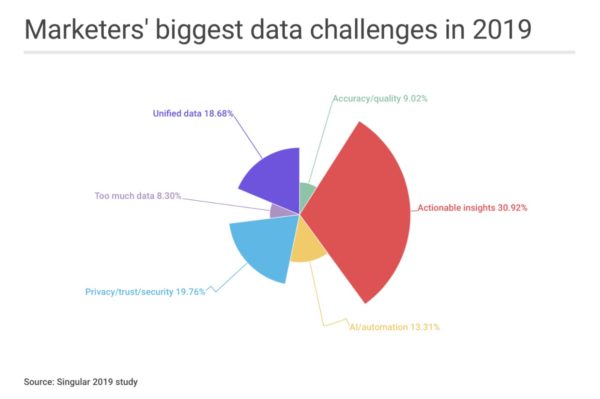
What to Consider When Performing Marketing Data Analysis
Have you ever been cruising down the road when an oncoming car drives through a huge puddle and splashes yours in the process?
For a moment, there is so much water on your windshield that you lose all sight of where you are going, and your heart stops. Then the wipers kick in, allowing you to see the road and breathe again.
It’s a scary thing to not be able to see where you are going. Unfortunately, marketers often do that very thing in their marketing campaigns. And while it isn’t life threatening, it is most certainly a threat to their business.
Marketing isn’t just creative; it’s technical. Performing a marketing data analysis is what allows marketers to know what is working and what isn’t. Without data, marketers are in the dark, but fortunately, we have a plethora of data at our fingertips to show us the light.
At the same time, that plethora is more of an avalanche, and we now know that too much of a good thing isn’t a good thing. It’s overwhelming and therefore ineffective, and it can cause more problems than it’s worth.
At Viral Solutions, we put a strong value on data, but more importantly, we strive for accurate, actionable data. Too many business owners and marketers get so swept up in data that they fail to consider context and the fact that tools aren’t always 100% accurate.
Just look at the findings of a 2019 Singular survey that asked marketing leaders about their biggest marketing data challenges:
- 30.92% Actionable insights
- 19.76% Privacy/Trust/Security
- 18.68% Unified data
- 13.31% AI/Automation
- 9.02% Accuracy/Quality
- 8.30% Too much data
Aside from privacy and AI, the results are really showing that there is a problem with being able to use data—marketers struggle to make sure their data is actionable, unified, and accurate, and they are overwhelmed by the sheer quantity of it.
What You Should Consider When Performing a Marketing Data Analysis
Until we address these issues, we can’t put our data to good use. Data certainly isn’t cut and dry, and there is a lot to consider in order to ensure you are reading your data properly and therefore getting accurate results.
Let’s look at 7 things you need to consider when performing a marketing data analysis…
1) It’s Too Easy to Make Wrong Conclusions
Too often, marketers find themselves working with incomplete and inaccurate data that leads to wrong conclusions. Confirmation bias happens when we want to confirm what we think is true, so we justify it through our data even though that might not be what the data is indicating.
Instead of trying to prove that our marketing assumptions and/or work is right through our marketing data analysis, it’s always better to be skeptical so that we can come to an unbiased determination.
In a Moz article, Tom Capper explains that before jumping to a conclusion based on a correlation, we need to consider other possibilities, such as…
- Complete Coincidence – Are we comparing so many data sets that some just end up being similar?
- Reverse Causation – Could we look at it from a completely different angle?
- Joint Causation – Could there be a third factor that is contributing to the result?
- Linearity – Are we comparing two data sets that have a similar rate of growth or decline causing them to be highly correlated?
- Broad Applicability – Does the relationship of this data only exist in certain niche scenarios?
According to Capper, when your data doesn’t get an answer of “No” to all of those questions, the data has failed.
Here are some additional questions that prevent marketers coming to wrong conclusions when looking at data:
- Are there any other factors that could be contributing to these findings?
- Was an alternate factor improved accidentally that contributed to the result?
- Was this case study unique in some way that would keep us from duplicating the results?
- Consider context—does the time of year change things?
2) Tools Aren’t Always Accurate
Most analytics software, including Google Analytics, have inaccuracies that skew the data. For example, they often group things such as website hits into sessions, they perform differently from one another under sampling, they are easily manipulated by the user, and there can be inaccuracies related to ad blockers.
If you compare the ranking results of different search analytics tools, you will get much different results. Every tool has strengths and weaknesses, so it is important to know how to perform analytics audits so that you understand when you are and aren’t being guided properly.
This becomes even more of a problem when data is combined from multiple sources. Each platform looks at data differently, and when you try to combine it, you are not always combining apples and apples. Even combining clicks from one platform to another, for example, can yield a combined data set that is mucked up with some clicks that are filtered, some that aren’t, some that are last click, some that are first click, some that are the result of bundled keywords, etc.
3) Accuracy Doesn’t Come from Small Numbers
If you are basing marketing decisions on data that comes from a sample of only a couple of situations, you are basing your decisions on inaccurate information. Your samplings must contain a high enough number of examples from which to draw accurate conclusions. Enough said.
4) You Have to Put the Omni in the Channel
One of the easiest ways to misinterpret data is to look at it linearly. As Stephanie Rogers from MERGE Boston points out, “You may see a lift in online search activity when running TV ads, but if you only assess search in isolation you may not realize that correlation.”
Each channel has an impact on the whole; therefore, we have to analyze our data in a holistic way (i.e., omnichannel marketing). Isolating data and staying siloed doesn’t show us the whole picture.
5) Data-Based Benchmark Approaches Help Cut the Chaos
The volume of data and the differences in analytics platforms can make for a hot mess that reduces the accuracy and effectiveness of marketing data analysis.
Keeping in mind the issues involved with being able to accurately interpret data, Daniela Paven from The Ad Store New York suggests using a data-based benchmark approach. By first testing a strategy using some assumptions, you can then gather data from the test to discover what worked and what didn’t work. Then, you adjust your approach based on that data and benchmark your starting point from which you can measure and adjust.
6) Consumer Context Cannot Be Forgotten
Don’t be so busy measuring clicks and search engine optimization that you forget to analyze why consumers are doing what they are doing. Marketing is becoming more human centric than transactional, so we can’t just look at the transactional data. We need to find ways to measure the relationships we build through our marketing efforts.
When designing marketing campaigns, Laura Rueckel, Group Director of Integrated Marketing at Coca-Cola North America, recommends asking yourself questions such as the following:
- Where is the customer receiving the message?
- What emotional state is the customer in?
- Are they rushed or relaxed while browsing?
In addition, you want to understand why your customers are buying certain brands, why they are making certain purchases, and why they are not behaving the way you would expect. When you know those things, you can plan a targeted campaign that catches people at the right time and in the right place with the right message.
Data that is relevant to consumer context includes things such as…
- Environmental conditions such as news, location, weather, traffic, time of day, time of year, events
- Real-time transactions
- Browsing history
- Cart abandonment
- Social media
7) Small Data Is Just as Important as Big Data
It’s easy to get wrapped up in data and fancy pie charts, but sometimes the biggest gems are not available in that format. They come in the form of comments and survey responses that can help us discover opportunities and gaps that we otherwise wouldn’t have found.
Mark Schaefer of BusinessGrow.com, for example, indicated that he came across “one stray comment on one survey that was an early warning sign of a severe quality issue. It was so serious in fact, that one comment led to an investigation and a multi-million-dollar capital project.”
In Closing
Like we stated above, we love data at Viral Solutions, and because of that, we have mastered marketing data analysis. We know how to interpret it, how to avoid misconceptions, and how to ensure it is actionable so that our customers are being led forward as if high beams are lighting their way.
We can do the same for you!
Contact us today to get started.


